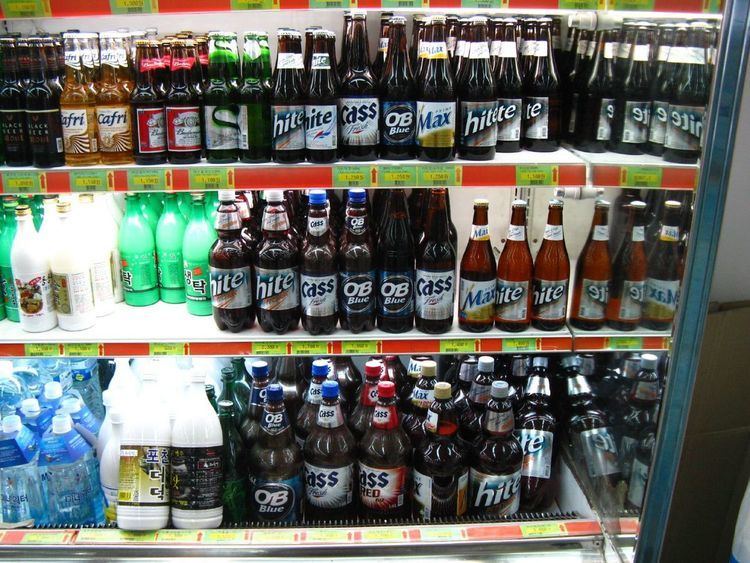Hangul 맥주 Revised Romanization maekju IPA [mɛ̝k̚.t͈ɕu] | Hanja 麥酒 McCune–Reischauer maekchu | |
 | ||
Beer, called maekju (맥주; 麥酒) in Korean, was first introduced to Korea in the early 20th century. Seoul's first beer brewery opened in 1908. Two current major breweries date back to the 1920s. The third brewery established in Korea, Jinro Coors Brewery, was founded in the 1990s. It was later acquired by Oriental Breweries (OB). Hite Breweries's former name was Chosun Breweries, which was established in 1933. The company changed their name to Hite Breweries in 1998. OB Breweries established as Showa Kirin Breweries in 1933. The company changed their name to OB Breweries in 1995.
Contents
- Domestic brands
- Korean Domestic beers
- History of beer and beer market in South Korea
- Foreign beers in South Korea
- Microbreweries
- Beer Festivals in South Korea
- Former products
- Criticism
- References
The South Korean beer market is currently dominated by two major manufacturers, Hite-Jinro and OB, with several brands being sold in the local market. Most restaurants and bars in Korea only have one of these beer brands on tap (Hite or OB's Cass), as they are largely regarded to be similar in taste and price (they are mostly brewed from rice). Imported beers are largely available in Korea, but are generally expensive - usually costing at least ₩8,000 and as much as ₩15,000 for a pint of Guinness in bars in downtown Seoul. Local brands usually cost around ₩3,000, thus presenting a cheaper option. Recently, microbreweries have sprouted up throughout the country, showing increasing signs of sophistication. Out of Korea's mass-produced beers, only two are brewed from 100% barley malt: Max (Hite) and OB Golden Lager.
The lack of microbreweries in the South Korean market is attributed to onerous government regulations. This has constrained small-size brewers from supplying beer to locations under their ownership. These laws were eventually relaxed in June 2011, granting several small players a share in the local beer market.
A growing trend in South Korea is home brewing. While ingredients and supplies are still limited, there are many households brewing their own beer. Various brewing clubs also exist to help guide newcomers through the processes of home brewing in South Korea; one such club being Homebrew Korea.
Domestic brands
Korean Domestic beers
History of beer and beer market in South Korea
Beer was first introduced to Korea in the early 20th century. Seoul's first beer brewery opened in 1908. The two current major breweries date back to the 1920s. The third brewery established in Korea, Jinro Coors Brewery, was founded in the 1990s, but was later acquired by Oriental Breweries (OB).
In the past, Korean consumers had a preference to lagers versus ales or wheat beer; with the aforementioned flavors being rather unfamiliar. Recently, beer consumption has become more widespread. With the Free Trade Agreement (FTA) enacted, the importation of foreign beers tripled in 2015 compared with the previous year. The beer brand Paulaner topped sales in the first half of 2015, followed by Hoegaarden and Guinness. Recently, Korean society has shown an interest in drinking alcohol alone at home, with single-person households being the most common. This trend is depicted in the Korean TV drama Drinking Solo (Honsul).
Since 2014, the South Korean beer market has largely been dominated by OB and HiteJinro. Recently, Lotte Liquor has entered the beer market with Kloud, creating a three-way competition.
Foreign beers in South Korea
Various foreign beer brands are available on the Korean market, with interest rapidly increasing. Major brands such as Hoegaarden, Heineken, and Budweiser rank high in the Korean beer market. Due to the cost of malt, Korean beer makers have largely turned to using corn, rice, and tapioca for manufacturing. Korean beer's malt rate is about 7%. Comparatively, German beer's malt rate is 100% with Japanese beer being 66%. With the signing of the Free Trade Agreement (FTA) between Europe and Korea in 2014, the import of foreign beers has drastically increased.
Microbreweries
Beer Festivals in South Korea
Former products
Criticism
The Economist magazine published an article criticizing South Korean beers to be as boring or worse than North Korea's Taedonggang Beer. The magazine claimed some South Korean beers skimp on barley malt, using corn and rice instead. The article further described the problem as a result of the national market being a cramped duopoly (Hite-Jinro and Oriental Brewery) that prevented microbreweries from entering the market. South Korean beer companies denied the allegations, one specifically saying that "most (South) Korean beers contain more than 70 percent malt, and some including Hite Max of Hite and OB Golden Lager of OB contain 100 percent malt. Rice and corn are not cheaper than malt, and these grains are used in the mixture to generate a mild taste." Despite the negative reactions from the South Korean breweries, many local beer drinkers are still dissatisfied with the taste of local beer brands.
